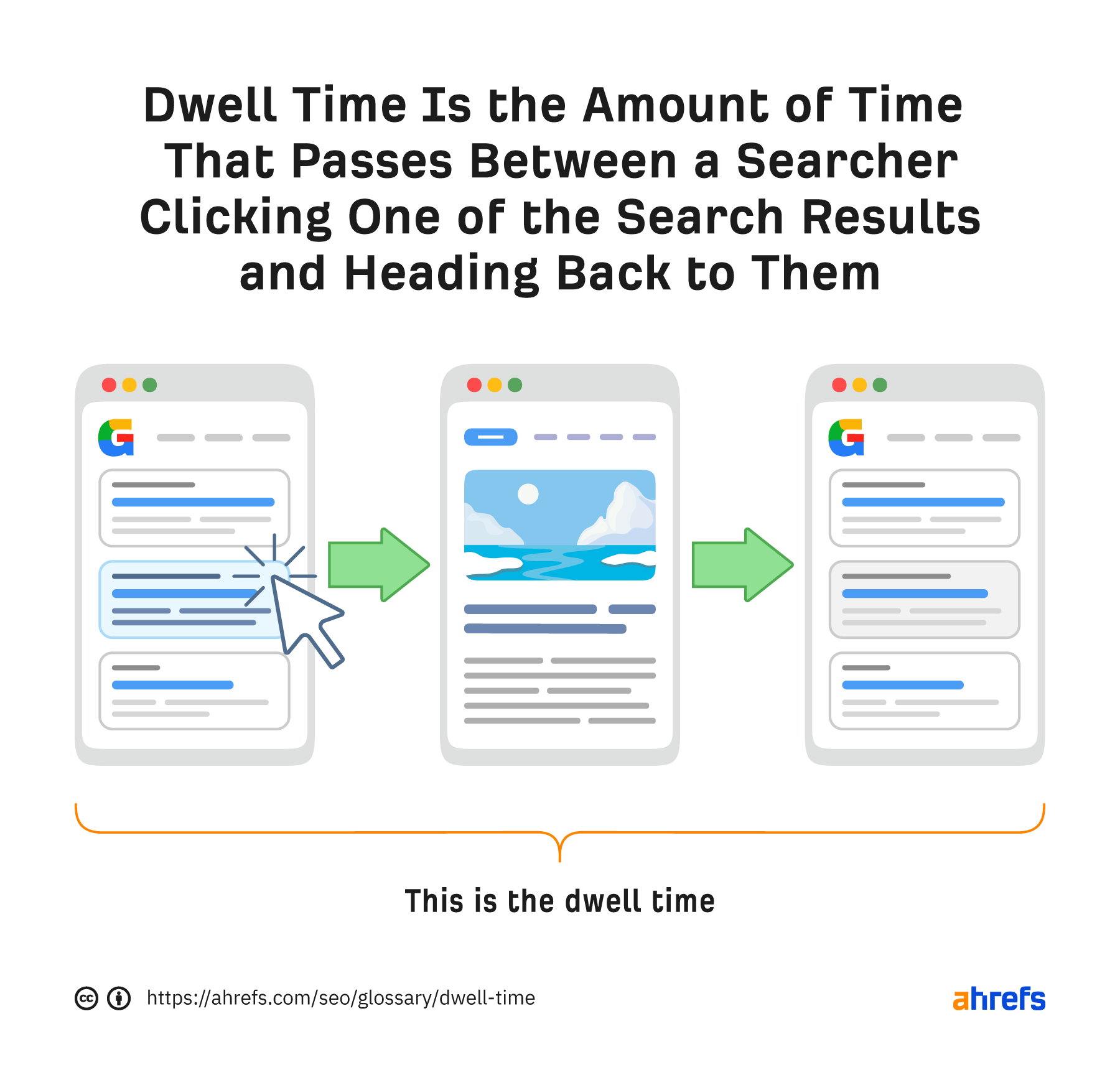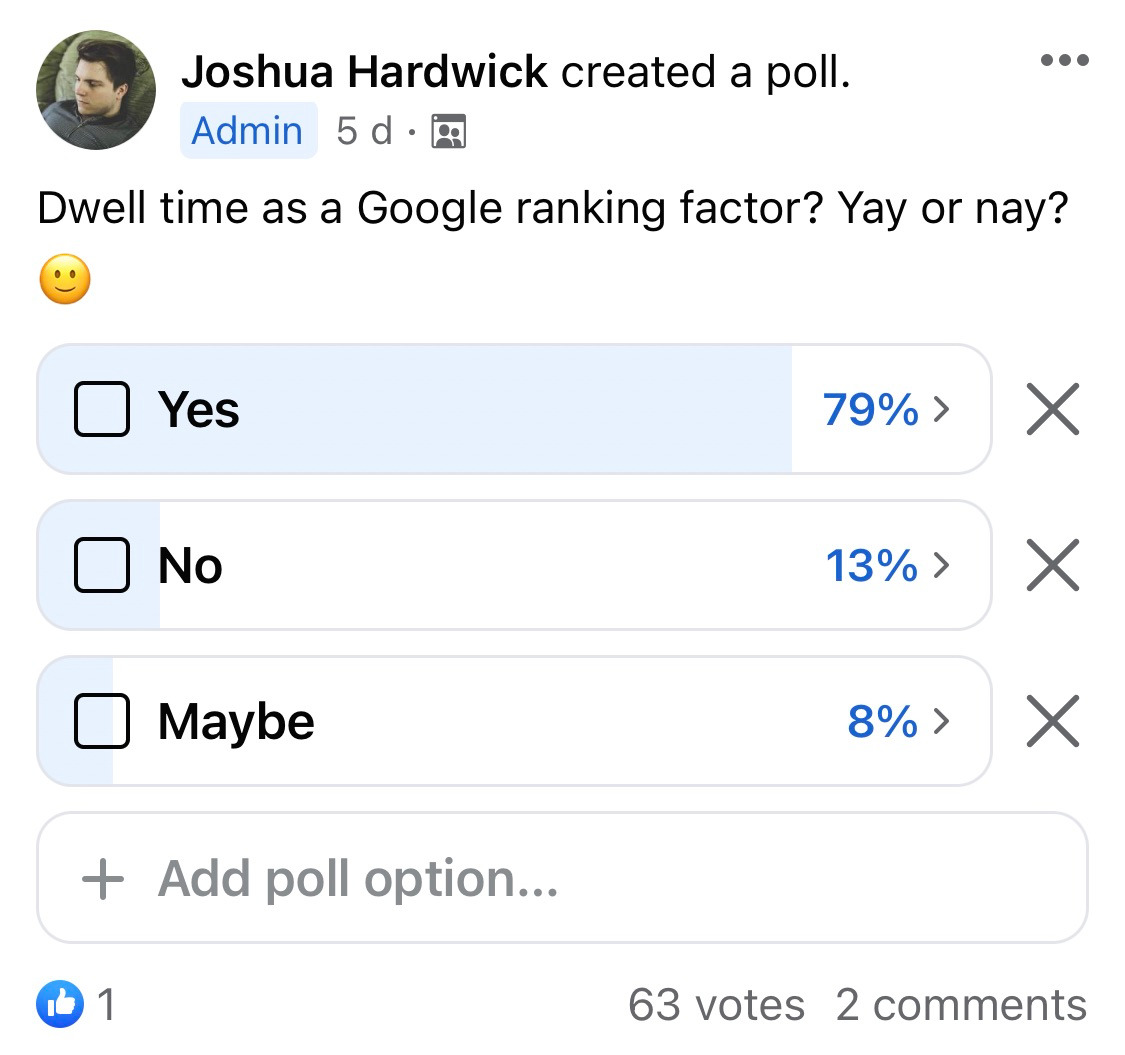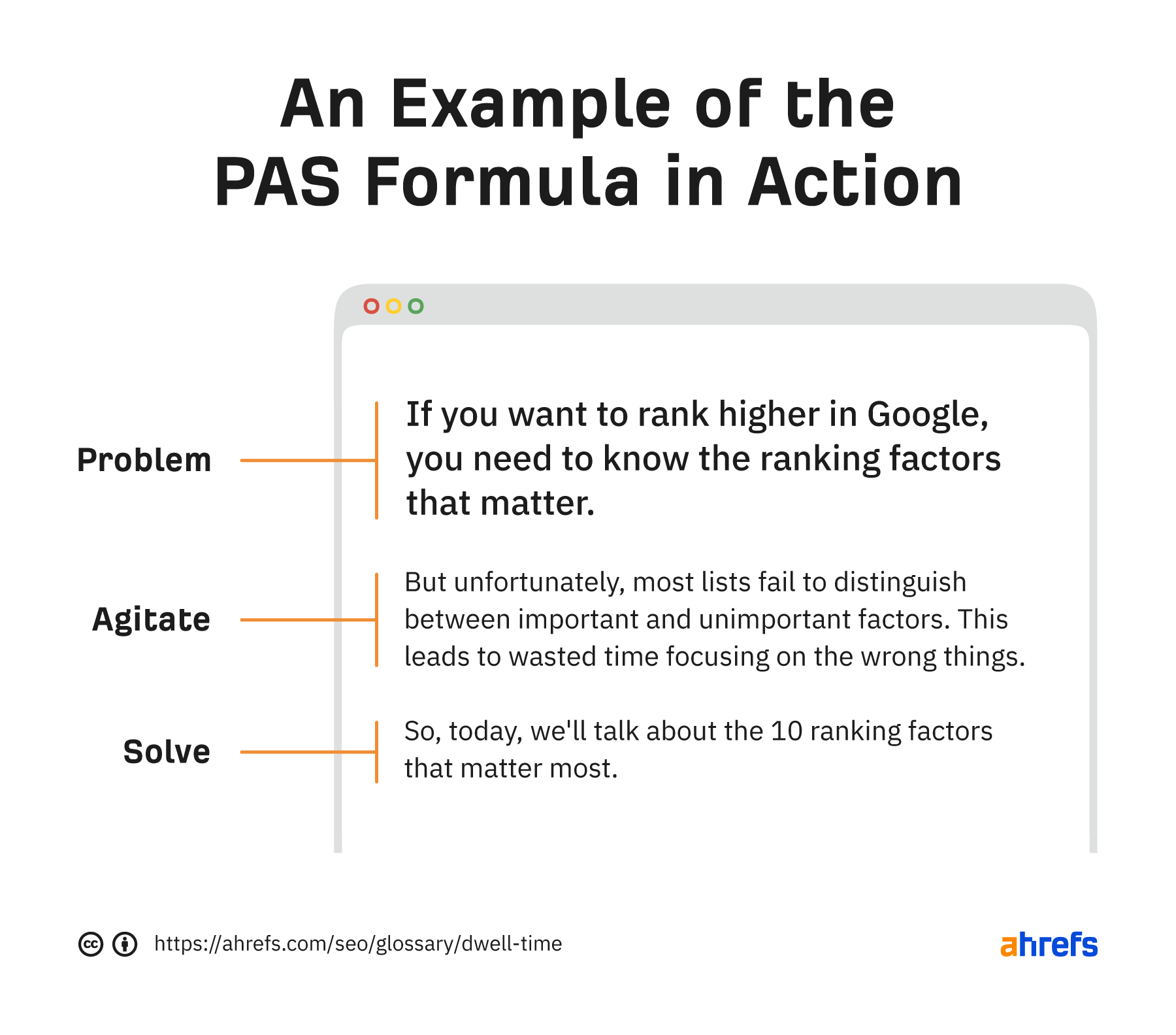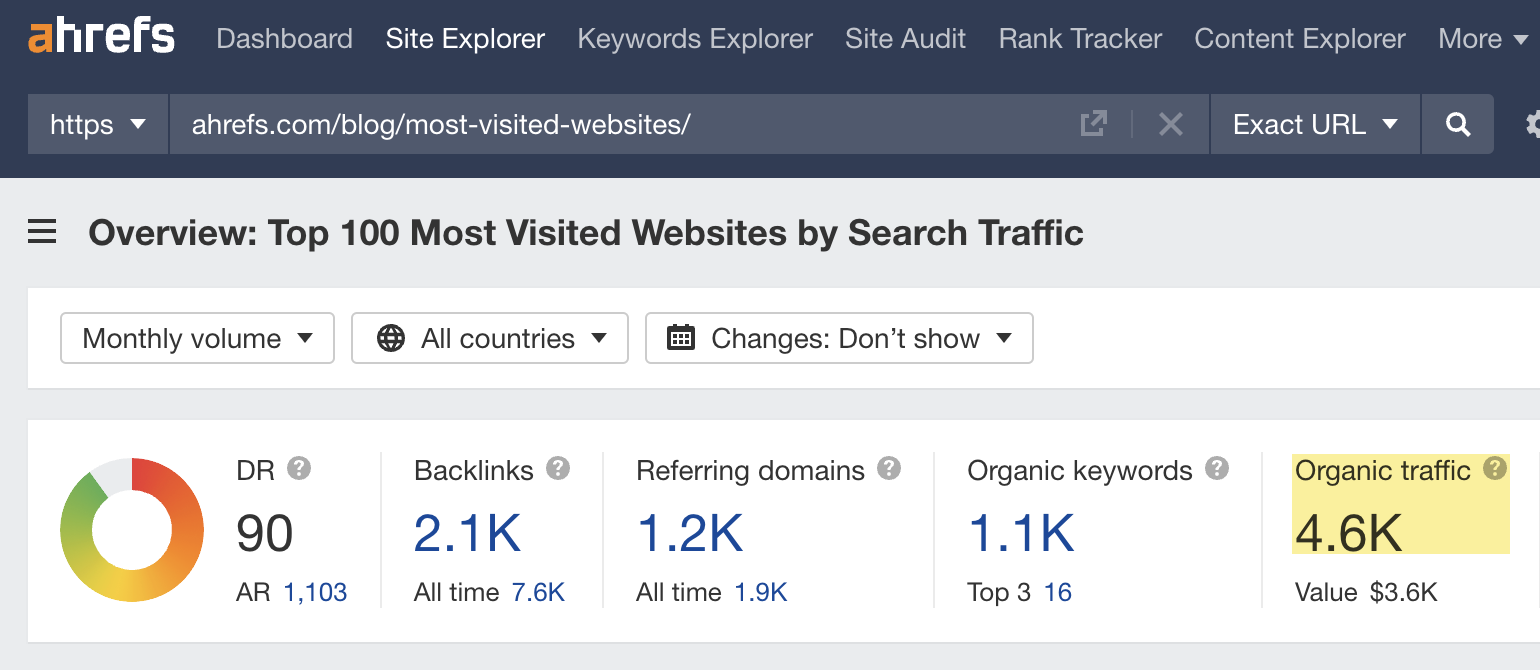Dwell Time
What is Dwell Time?
Dwell time is the amount of time that passes between clicking one of the search results and heading back to them. It’s not the same thing as bounce rate, time on page, or any other metric in Google Analytics.
Example
Let’s say you click on a search result, stay on the page for two minutes, then click back to the search results. Your dwell time on that page is two minutes.

How does dwell time differ from bounce rate and time on page?
Bounce rate and time on page are different metrics unrelated to dwell time. They’re only similar in the sense that they’re measures of user activity or engagement.
Bounce rate
Bounce rate is the percentage of visitors that take no further action after landing on a web page. It has nothing to do with whether they go back to the search results.
Time on page
Time on page is how long a visitor spends on a page before going somewhere else. That could be back to the search results, to another page on your website, or to a different website.
Is dwell time a ranking factor?
Nobody knows for sure as there’s no official statement from Google. We know they’ve used it to train models[1], but not if or how these influence live algorithms. Google employees have said many times that clicks data is unreliable and that it’s not a ranking factor.[2][3][4]
Despite this, most of our polled customers think it is a ranking factor.

Does dwell time make sense as a ranking factor?
Kind of. There’s no doubt that you could use dwell time to gauge user satisfaction. But it might not be a reliable way to do so because it doesn’t always correlate with user satisfaction. The table below illustrates why.

Google has hundreds of ranking factors, though—so dwell time may make sense somewhere in the mix. They may also use it for some queries and not others.
There are many scenarios where shorter dwell time is an indication of quality. For example, anytime someone is looking for a quick piece of reference information, such as a zip code or phone number for a business.
One more scenario in which dwell time might be a false flag for content quality and user satisfaction: shopping. Often when I’m shopping, I may click back and forth rather rapidly among multiple results because I’m just at a stage where I’m comparison shopping, maybe for price or certain features.
Best practices for improving dwell time
Ranking factor or not, you can’t improve dwell time because there’s no way to calculate it. That’s because search engines don’t share dwell time data. So it’s better to focus on doing what you can to improve searcher satisfaction and engagement. Let’s look at a few ways to do that.
I think Google probably tries to measure and use engagement as part of its ranking algorithm. I think precisely how it does this isn’t known, I think too many SEOs obsess that it must be clickthrough rate. It largely doesn’t matter. As marketers, you want people engaging with your content first and foremost. So focus on that, and you’ll probably align with what Google wants.
1. Hook readers in the intro
People have short attention spans. Unless you can grab their attention right away, they’ll head back to the search results. You can do this with a proven intro formula like the Problem-Agitate-Solve (PAS) formula.
Here’s an example:

2. Keep search intent in mind
People have a goal in mind when they search Google for something. We call this their search intent. You can often get a clear idea of intent from the keyword itself, but not always.
For example, it’s pretty obvious that people searching for “SEO tips” want a list of SEO tips. But what about people searching for “advanced SEO?” Do they want advanced SEO tips, a step-by-step tutorial, or something else?
It’s impossible to know for sure, but the top-ranking results are usually a decent proxy.
In the case of “advanced SEO,” most are lists of tips and techniques.

3. Don’t clickbait
People choose search results based largely on their title tag and meta description. If they’re misleading, they’ll hit the back button.
For example, let’s say we target “advanced SEO” with a post that has this title and meta description:

If we only give basic tips in that post, it won’t meet searchers’ expectations and dwell time will be low.
4. Cover relevant subtopics
People don’t always want the answer to one question when searching in Google. And even if they do, finding that answer can often lead to more questions.
For example, if someone searches Google for “what is a H1 tag?,” they want a definition. But learning what an H1 tag is probably leads them to more questions, like why are they important, what do they look like, and how long should they be?
Covering relevant subtopics can keep searchers consuming your content for longer.
Here’s an easy way to find them:
- Paste your domain into Ahrefs’ Site Explorer
- Go to the Content Gap report
- Paste the URLs of 3-4 top-ranking pages for your main keyword
This report shows keywords that at least one of the top-ranking pages ranks for, but you don’t. You can often find keywords that represent relevant subtopics by sifting through them.

5. Keep content up to date
People don’t want outdated content for some search queries.
For example, our list of the top 100 most visited websites ranks in the top 10 for its main keyword and gets an estimated 4.6K monthly search visits. But we haven’t updated the list for almost two years.

As a result, it’s likely that many searchers find this dissatisfying and click back to the results. In which case, our page’s average dwell time would be low.
To solve this problem, we should update the content every now and again.
6. Add internal links to useful resources
People are less likely to head back to the search results if they have an alternative path. You can give them this by adding internal links to other useful resources.
Here’s a quick way to find relevant internal link opportunities:
- Sign up for a free Ahrefs Webmaster Tools account
- Crawl your site with Site Audit
- Go to the Internal Link Opportunities tool
This report shows contextual internal link opportunities based on your website’s keyword rankings. To do this, it searches for mentions of keywords you already rank for on crawled pages.
Here’s an opportunity it found on our blog:

In our post about fast link building, we talk about using search operators. So the report suggests that we add an internal link from that mention to our post about search operators.
FAQs
Who created dwell time?
Duane Forrester, former Senior Project Manager at Bing, was the first to mention dwell time in his 2011 blog post.[5] He explained that the time between when a user clicks on a search result and returns to them tells a potential story.
How do you calculate dwell time?
You can’t calculate dwell time because search engines don’t share this data. But, in theory, it’s the time between a user clicking on your result in the search results and clicking back to them.
What is the average dwell time?
Nobody knows because search engines don’t share dwell time data. Even if they did, knowing the average isn’t very useful. It’s likely to vary by industry, intent, and many other factors.
Related terms
References
- “Google Brain Canada: Google Search Uses Click Data For Rankings?”. Search Engine Roundtable. September 11, 2017.
- “Google vs. Moz On Clicks Influencing Search Ranking”. Search Engine Roundtable. March 24, 2016.
- “I am Gary Illyes, Google’s Chief of Sunshine and Happiness & trends analyst. AMA”. Reddit. February 7, 2019.
- “We’re not using such metrics”. @g33konaut. November 6, 2019
- “How To Build Quality Content”. Bing. August 2, 2011.


